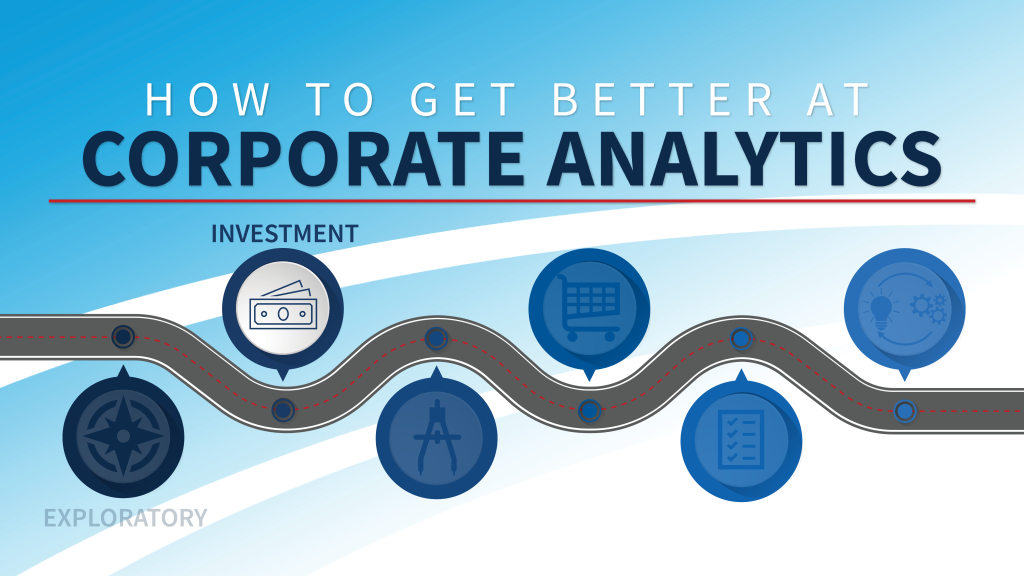So, you’ve explored, assessed, and positioned your case for bettering your corporate analytics. Now what?

Let’s say you wake up one day with a fantastic vision for launching your corporate analytics initiative… You’re totally positive it will make beaucoup dollars and leverage the hottest technologies making your firm the talk of your industry. You can already smell the new raise. So, you walk into the VP’s office, explain your great idea, and ask for money to make it happen. Next, she jumps out of her seat completely elated and starts shoving dollars into a banker box for you to haul off and put to good use on your first groundbreaking AI project…
“This is a pleasant fiction, isn’t it?” -Lucilla, Gladiator (2000)
It shouldn’t surprise you that the days of poorly planned analytics programs getting funding are nearly behind us. Too many organizations have been burned by the kneejerk reaction of hiring data scientists without a good way to enable them in the organizational culture.
Well, you’ve got to start somehow! So how? First, if you haven’t already, I’ll invite you to read my previous blog, on Phase Zero: Exploratory Phase. If you follow the steps recommended there, you will have already articulated a well-thought-out value proposition for developing a Data Strategy and obtained approval to write a formal business case to implement the strategy.
First Consider Culture and Sponsors
You’ll need to write a well-developed, robust justification for why your organization should invest in analytics capabilities, complete with financials that will pass muster, i.e., the Business Case. It’s the main event in the Investment Phase of our “to Get Better at Corporate Analytics” framework. However, before diving into the business case elements, it’s helpful to pause and consider two key things about your business context:
- Culture: How will you build better analytics capabilities given your organizational culture?
- Generating Sponsorship: How will you get and sustain buy-in and approval from the appropriate authorizing sponsors?
Let’s briefly unpack those questions. Regarding Culture, analytics endeavors can be touchy for some folks. In fact, culture is the hardest part about implementing analytics capabilities, and digital transformation more broadly. There are many reasons for this, ranging from personal trust issues with data sets, to feeling threatened by automation, to resentment around business processes changing. Each of these cases could easily be a blog of its own. Suffice it to say that culture warrants consideration on your part in terms of how you articulate your business case up and across the organization. Be sure to rely on the wisdom of trusted colleagues from different parts of the business as you plan how you’re going to deliver your talk tracks.
The second point: Generating Sponsorship – is critical. Sponsors are the leaders in the company whose buy-in you need to achieve your analytics objectives, who will support you and reinforce the right behaviors in the culture for your efforts to be successful. Let’s also denote “approving” sponsors as the people with the power to say “yea” or “nay” over your work moving forward, and “authorizing” sponsors as the ones who hold the purse strings (They might be the same person or group of people). So then “generating sponsorship” is the process of getting them all on board. Sometimes sponsors are all-in, and it takes little persuasion (although rarely will they ever be as easy as our fictional VP above). Others might be diametrically opposed and shoot you down before you start. But most are somewhere in between at first.
So, to generate sponsorship, you’ll want to have a plan. This can be an art and a science, and this topic could be another entire blog of its own. The key is that it will take persistence, consistency, and usually a series of formal and informal discussions to “bring them along” with your vision. And even when you do get approval and budget, generating and sustaining sponsorship never really stops – it needs to continue as long as the effort continues – and sometimes even after it is implemented. Think of it as generating “durable sponsorship.”
“And even when you do get approval and budget, generating and sustaining sponsorship never really stops – it needs to continue as long as the effort continues – and sometimes even after it is implemented. Think of it as generating ‘durable sponsorship.'”
It’s All About the Business Case
Now it’s time to develop your business case for implementing corporate analytics. This may sound like a one-and-done deliverable, but it’s actually as much of a process as it is a document. There may be stages and iterations, depending on your culture and the sponsors, as mentioned above. The overall idea is to “bring them along” to your vision and understanding of value, while anticipating their objections or reservations through however many layers of approval are needed.
Here are the steps:
- Present the first iteration of the business case positioned as a request to “study” the opportunity. This is about getting explicit agreement that it’s worth devoting time and resources to develop the plan for implementation. At this stage, you’ll want to present preliminary budgetary estimates in high-level categories over three to five years. Don’t go for precision here, go for strategic language and non-committal financial estimates that executives can begin to mull over in their minds. Sometimes the answer you are looking for is truly “not no”, i.e., no answer at all, rather than “yes”. Let them understand what you are asking, and don’t force premature asks or approvals.
- Do a small pilot that’s set up for success. At this point, you’ll already have candidate projects in mind for how to prove the feasibility of the future capability. Let it be simple and small, but strategically relevant to the sponsors. Perhaps you have an authorizing sponsor whose passion is customer service – go with it. Maybe the CEO is an engineer by training – look at maintenance data or process efficiency. Play to the audience and stick with clarity over razzle-dazzle. Lastly, give a report to get them even more engaged and eager for your later approval request presentation.
- Assess your current state analytics capability. What’s the quantitative bench strength like in your organization? Is there anyone who uses analytical tools other than Excel? How do they get their data? Does it support analytics needs very well, or is it more ad hoc and analysts asking for data request favors? Is anyone focused on data management standards? All of this research helps to inform the magnitude of the effort and where you’ll really need to start if you move into implementation. You must know all this to build a robust budget ask.
- Develop the Data Strategy. This is the central narrative around which you build your planning level budget estimate. Key elements include:
- Vision for the analytics capability,
- Value Proposition/Benefits to the organization,
- Demonstrating alignment to corporate strategy,
- Organizational structure (near term and long term),
- Required platforms & tools, and
- Multi-year roadmap for implementation driven by corporate strategy.
- Present the business case for approval with financials. Not to be melodramatic, but now it’s showtime. Here’s where your hard work will pay off. It goes without saying that you need a robust financial model that supports your Data Strategy narrative. You will also want to study your audience, using input from your trusted colleagues, to maximize your chances of success. If possible, try to get unofficial approval from key sponsors prior to the formal presentation, so the approving sponsor can look around the room at the other executives and see them nodding their heads in agreement. Better yet, let them share in the credit for the idea. Finally – and this is important – beyond the financials, tie the initiative to core values, key executives’ legacies, and long-term business sustainability in the digital age.
If you deliver on all those steps, you’re in good company – few organizations fully appreciate the implications of a successful Data Strategy, and the planning and commitment that really takes. Even if you don’t get the approval at first, have faith – it’s only a matter of time before the CEO comes knocking for another go – and they’ll remember you from the first time.
I look forward to sharing the next phase – “Architecture.” Stay tuned!
Josh recently led a webinar that focused on the Investment Phase of our Data Strategy Group’s Framework. Delivering a solid business case for investment in analytics, tailored to and adopted by your executive audience, is the most important phase in building your analytics capability. This is the second webinar in our series on “How to Get Better at Corporate Analytics” Click the button below to watch the full webinar.
Written By:

Josh Pack, PhD
Practice Leader, Strategic Management & Data Science
Data Strategy Group





